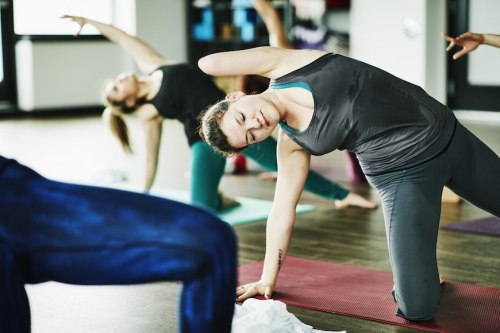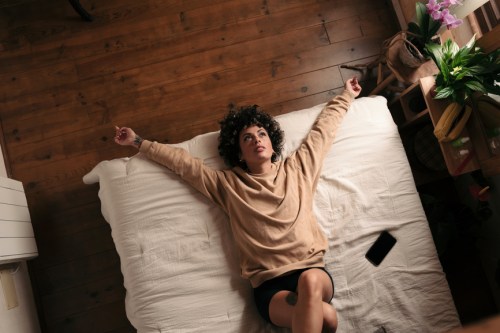I turned to yoga to heal after a breakup—this is what happened
A Well+Good editor turned to yoga for heartbreak after a breakup with a long-term BF. Here, she talks about all of the benefits and how it helped her heal.

About ten minutes into a vinyasa flow, I’m standing with my hands at “heart center” (over my newly-broken organ), and the yoga instructor tells the class to set an intention for our practice. “This could be something you need in your life today,” he says. “Dedicate your practice to this now and channel it throughout the class.”
My intention, as of late? To find self-love. I’ve recently gotten out of a four-and-a-half-year-long relationship, I’ve just completed with my Saturn Return chaos (you know, that major and trying life-change that happens around the age of 29), and I’m in need of a serious reboot of my sense of self-worth.
While many newly exed may turn to boxing (the bag’s a great target) or hygge with a truly inspiring Netflix programming, yoga seemed to be the perfect outlet for my heartbreak. It’s not new to me, but there’s just something so relaxing about the sense of clarity that comes post-vinyasa. It’s something I wanted to explore further, and more consistently, once my life’s foundation seemingly shattered.
“If you take a moment to pause and clear your mind by focusing on your breath, you’ll have a better chance of looking at things through a clear lens after class.” —Beth Cooke
“Yoga gives you a chance to quiet the mind so you can sort out not only the physical body but the emotional body,” says Beth Cooke, a New York City-based yoga instructor. “When you’re emotionally charged, your thoughts can get tangled and caught up with your emotions and the stories you make up in your head. So if you take a moment to pause and clear your mind by focusing on your breath, you’ll have a better chance of looking at things through a clear lens after class.”
Considering all the dark emotions and not-so-pleasant stories that were swimming through my mind—making work and other day-to-day functions that much more difficult—this was a welcomed experiment to clear it all out. And, though I’ve never been the type to “Om” in yoga or say “Namaste” at the end of class, I was ready to thoroughly immerse myself into the practice—woo-woo-ness and all. Keep reading to see how yoga helped emotionally, how it eases post-breakup pain, and how it brought me back to my feet (even after so many inversions).

Yoga helps to tame your emotions
Yoga differs from other forms of exercise, because it’s about what happens outside of class just as much as within the 60 minutes of physical work. “Yoga’s about learning to sit with yourself even when you’re uncomfortable, and simply observe,” says Cooke. You know that burning feeling in your thighs when you’re in chair pose for longer than is pleasant? Teaching yourself to simply breathe through the pain can equate to learning to be comfortable in life’s many un-comfortabilities.
“As anyone who’s gone through a breakup can tell you, emotions often times manifest themselves as physical pain in the body,” says Andrea Bogart, a yoga and meditation expert at Mindsail (I can vouch for that). “Working up a sweat releases endorphins—the feel-good hormones that regulate mood and lower the perception of pain, which help in overcoming physical heartache.”
“Hitting your mat regularly is likely to shift your ordinary responses into thoughtful perspective and compassion.” —Andrea Bogart
She adds that yoga’s particularly powerful because the foundations of the practice teach you how to create more awareness and how to be present. “When you’re in the here-and-now, you’re not dwelling in the past or worrying about the future,” says Bogart. “Hitting your mat regularly is likely to shift your ordinary responses into thoughtful perspective and compassion.”
There have been times where I’ll be in the office trying to write when I’m suddenly hit with a profound feeling of sadness. It’s disorienting and hard to overcome—I mean, the guy I used to share everything with is now completely gone from my life. It’s hard to work when I’m facing such traumatic emotions, but then I realize that I carry the basic tool of breath. As I’ve begun practicing yoga more regularly, I’ve started turning inward and focusing on my breath—only my breath—for at least a minute until the flood of emotions are shut with the gate of regained clarity. It’s powerful and it works (though it does take practice and consistency).
Yoga offers a shift in perspective
As I get into countless downward-facing dogs, I gaze at my surroundings from my upside down viewpoint. When the blood rushes to my head, I realize that my life’s been turned upside down too—I’ve had to move from the apartment I shared with my ex for almost three years, lost the two dogs I mothered (he kept them), and I no longer have this person that was my complete support system. And yet—I try really hard on the mat to focus on the techniques yoga’s teaching me, and see that though the world’s upside down in this pose, my arms and my legs are still holding me up. I think to myself: I still have the power to stay lifted.
“You’re literally shifting your perspective,” says Cooke. “You’re looking at your surroundings in all different viewpoints.” When you move your body around, it cultivates a stronger awareness that perspective is key, and moreover, it enables you check in with not only your body but your mind. “It’s a journey inward that guides you to connect to the present moment with compassion and acceptance,” says Bogart. “This awareness starts to inspire better life choices and a strengthening of the mind and the practice of letting go.”
Even breathing differently—via pranayama (control of breath)—gets you more conscious of your body, which Bogart adds is effective in calming the nerves, soothing the mind, and even elevating your mood. And certain asanas (poses) correlate with different chakras. “A lot open up and balance your heart chakra,” she explains. “When your heart chakra’s open, you’re flowing with love and compassion, quick to forgive, and more accepting of others and yourself.”
Serious healing starts to happen on the mat
Typically, in a yoga class, you’re asked to take from the mat what you need for your day. “Yoga allows you to get quiet with yourself and scan where you’re at physically and emotionally, and what you need for that day,” says Cooke. “It demonstrates that you have the tools to create your own happiness and give yourself what you need.”
And, physically, certain yoga poses can release emotional baggage. “Hip openers like pigeon pose are a great way to let go of negative feelings that don’t serve you anymore,” she says.
Besides that, one of the main purposes of yoga is to create space—something you undoubtedly need in your heart post-breakup. “You’re spending an hour a day focusing on your breath—something other than what’s happening in your life,” says Cooke. “It creates the space for healing and brings peace of mind. The more you focus on your breath, the more space you create in your mind—which can be used for the energy you put towards other things you want to do.”
With that newly clear mind, you’re less likely to spend that energy feeling down on yourself. “Take that energy to create a shift—this impact of yoga gives you more control over your mind, emotions, and your body,” says Cooke.
For awhile during my practice, I would burst out into tears during savasana, since so many emotions came up during that hour of holding different poses. It’s as if they stirred up all the trauma going on in my life. But now, it’s pure release. When I stood upright in my last yoga class, with both feet firmly planted on the floor, I felt the gravity of my body and its ability to remain upright. And I realized I’m strong on my own.
Here are the perks of practicing yoga without your mat. And this is how to avoid over-stretching (yes, it’s a risk!).










